2010 BMW MOTORRAD G 650 GS tyre pressure
[x] Cancel search: tyre pressurePage 15 of 136
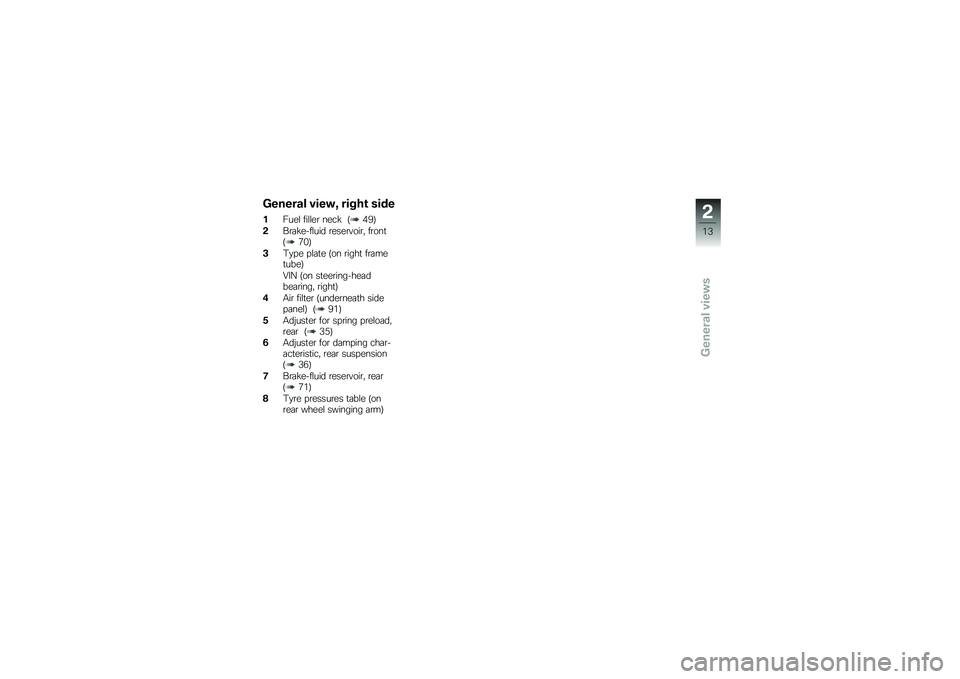
General view, right side
1Fuel filler neck (49)
2Brake-fluid reservoir, front(70)
3Type plate (on right frametube)
VIN (on steering-headbearing, right)
4Air filter (underneath sidepanel) (91)
5Adjuster for spring preload,rear (35)
6Adjuster for damping char-acteristic, rear suspension(36)
7Brake-fluid reservoir, rear(71)
8Tyre pressures table (onrear wheel swinging arm)
2
13
zGeneral views
Page 39 of 136
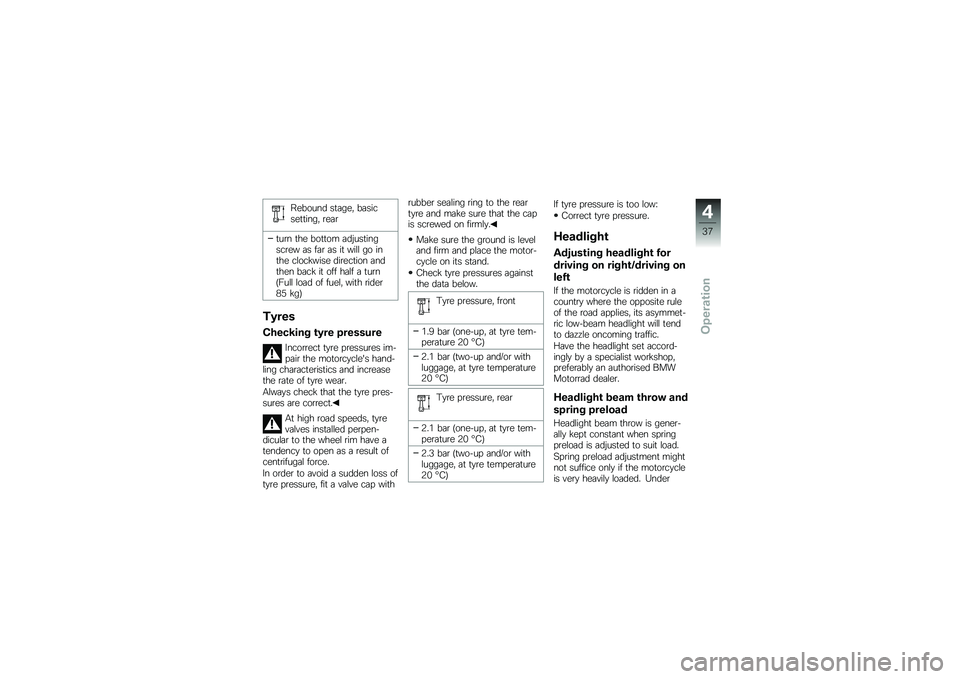
Rebound stage, basicsetting, rear
turn the bottom adjustingscrew as far as it will go inthe clockwise direction andthen back it off half a turn(Full load of fuel, with rider85 kg)
Tyres
Checking tyre pressure
Incorrect tyre pressures im-pair the motorcycle's hand-ling characteristics and increasethe rate of tyre wear.
Always check that the tyre pres-sures are correct.
At high road speeds, tyrevalves installed perpen-dicular to the wheel rim have atendency to open as a result ofcentrifugal force.
In order to avoid a sudden loss oftyre pressure, fit a valve cap with
rubber sealing ring to the reartyre and make sure that the capis screwed on firmly.
Make sure the ground is leveland firm and place the motor-cycle on its stand.
Check tyre pressures againstthe data below.
Tyre pressure, front
1.9 bar (one-up, at tyre tem-perature 20 °C)
2.1 bar (two-up and/or withluggage, at tyre temperature20 °C)
Tyre pressure, rear
2.1 bar (one-up, at tyre tem-perature 20 °C)
2.3 bar (two-up and/or withluggage, at tyre temperature20 °C)
If tyre pressure is too low:
Correct tyre pressure.
Headlight
Adjusting headlight for
driving on right/driving on
left
If the motorcycle is ridden in acountry where the opposite ruleof the road applies, its asymmet-ric low-beam headlight will tendto dazzle oncoming traffic.
Have the headlight set accord-ingly by a specialist workshop,preferably an authorised BMWMotorrad dealer.
Headlight beam throw and
spring preload
Headlight beam throw is gener-ally kept constant when springpreload is adjusted to suit load.
Spring preload adjustment mightnot suffice only if the motorcycleis very heavily loaded. Under
4
37
zOperation
Page 45 of 136
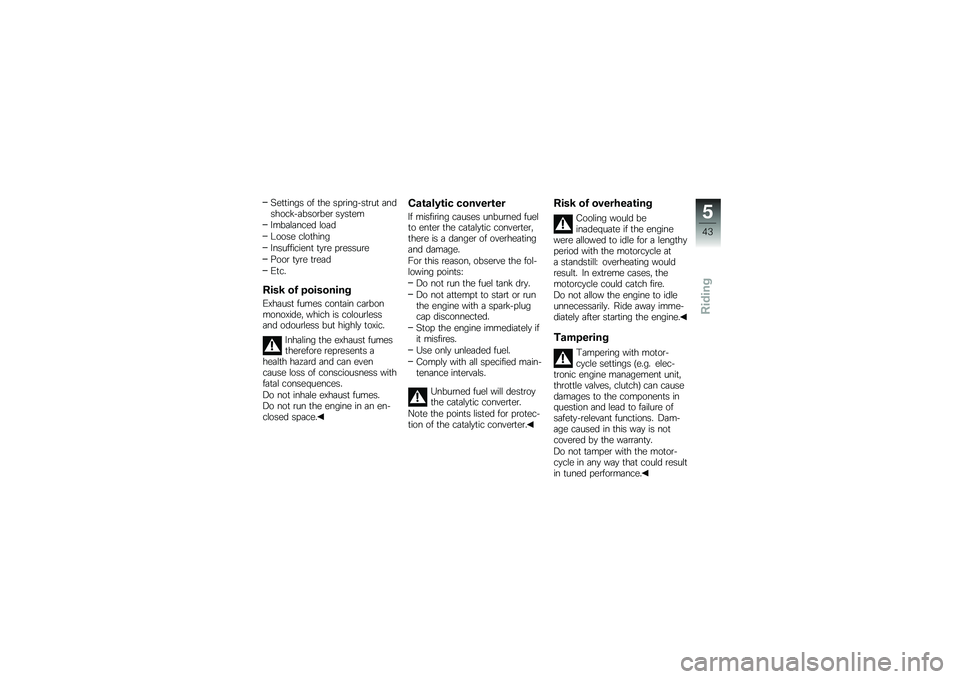
Settings of the spring-strut andshock-absorber system
Imbalanced load
Loose clothing
Insufficient tyre pressure
Poor tyre tread
Etc.
Risk of poisoning
Exhaust fumes contain carbonmonoxide, which is colourlessand odourless but highly toxic.
Inhaling the exhaust fumestherefore represents ahealth hazard and can evencause loss of consciousness withfatal consequences.
Do not inhale exhaust fumes.Do not run the engine in an en-closed space.
Catalytic converter
If misfiring causes unburned fuelto enter the catalytic converter,there is a danger of overheatingand damage.
For this reason, observe the fol-lowing points:
Do not run the fuel tank dry.
Do not attempt to start or runthe engine with a spark-plugcap disconnected.
Stop the engine immediately ifit misfires.
Use only unleaded fuel.
Comply with all specified main-tenance intervals.
Unburned fuel will destroythe catalytic converter.
Note the points listed for protec-tion of the catalytic converter.
Risk of overheating
Cooling would beinadequate if the enginewere allowed to idle for a lengthyperiod with the motorcycle ata standstill: overheating wouldresult. In extreme cases, themotorcycle could catch fire.
Do not allow the engine to idleunnecessarily. Ride away imme-diately after starting the engine.
Tampering
Tampering with motor-cycle settings (e.g. elec-tronic engine management unit,throttle valves, clutch) can causedamages to the components inquestion and lead to failure ofsafety-relevant functions. Dam-age caused in this way is notcovered by the warranty.
Do not tamper with the motor-cycle in any way that could resultin tuned performance.
5
43
zRiding
Page 46 of 136
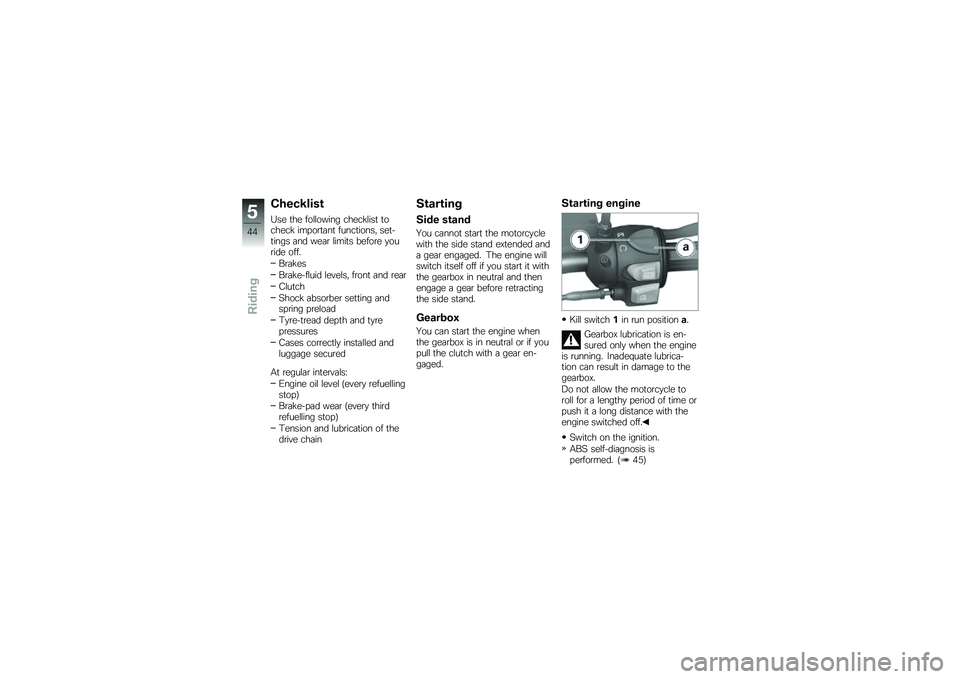
Checklist
Use the following checklist tocheck important functions, set-tings and wear limits before youride off.
Brakes
Brake-fluid levels, front and rear
Clutch
Shock absorber setting andspring preload
Tyre-tread depth and tyrepressures
Cases correctly installed andluggage secured
At regular intervals:
Engine oil level (every refuellingstop)
Brake-pad wear (every thirdrefuelling stop)
Tension and lubrication of thedrive chain
Starting
Side stand
You cannot start the motorcyclewith the side stand extended anda gear engaged. The engine willswitch itself off if you start it withthe gearbox in neutral and thenengage a gear before retractingthe side stand.
Gearbox
You can start the engine whenthe gearbox is in neutral or if youpull the clutch with a gear en-gaged.
Starting engine
Kill switch1in run positiona.
Gearbox lubrication is en-sured only when the engineis running. Inadequate lubrica-tion can result in damage to thegearbox.
Do not allow the motorcycle toroll for a lengthy period of time orpush it a long distance with theengine switched off.
Switch on the ignition.
ABS self-diagnosis isperformed. (45)
5
44
zRiding
Page 48 of 136
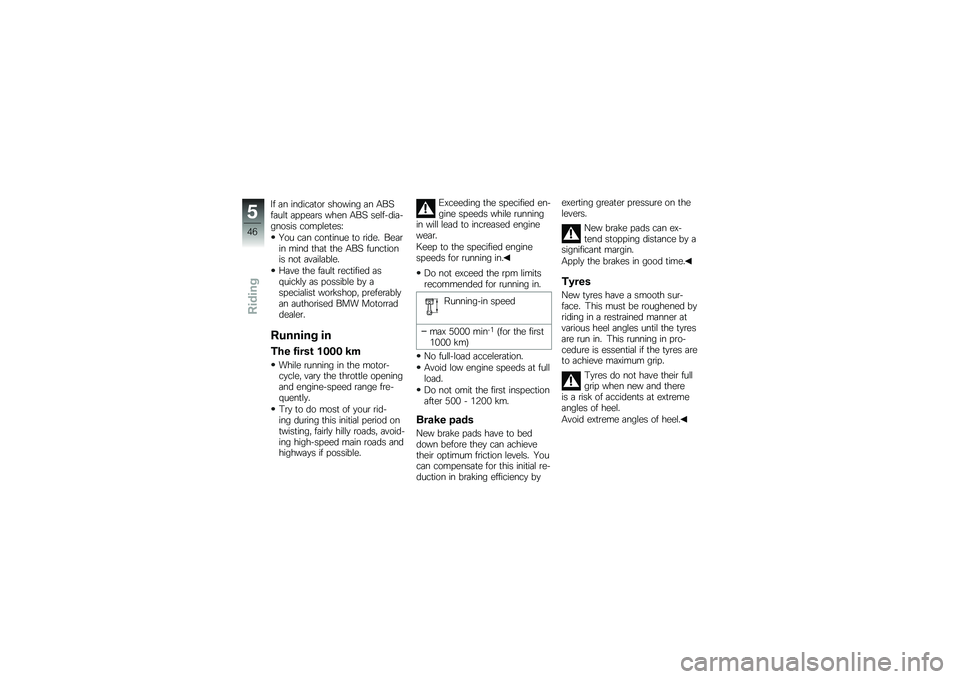
If an indicator showing an ABSfault appears when ABS self-dia-gnosis completes:
You can continue to ride. Bearin mind that the ABS functionis not available.
Have the fault rectified asquickly as possible by aspecialist workshop, preferablyan authorised BMW Motorraddealer.
Running in
The first 1000 km
While running in the motor-cycle, vary the throttle openingand engine-speed range fre-quently.
Try to do most of your rid-ing during this initial period ontwisting, fairly hilly roads, avoid-ing high-speed main roads andhighways if possible.
Exceeding the specified en-gine speeds while runningin will lead to increased enginewear.
Keep to the specified enginespeeds for running in.
Do not exceed the rpm limitsrecommended for running in.
Running-in speed
max 5000 min-1(for the first1000 km)
No full-load acceleration.
Avoid low engine speeds at fullload.
Do not omit the first inspectionafter 500 - 1200 km.
Brake pads
New brake pads have to beddown before they can achievetheir optimum friction levels. Youcan compensate for this initial re-duction in braking efficiency by
exerting greater pressure on thelevers.
New brake pads can ex-tend stopping distance by asignificant margin.
Apply the brakes in good time.
Tyres
New tyres have a smooth sur-face. This must be roughened byriding in a restrained manner atvarious heel angles until the tyresare run in. This running in pro-cedure is essential if the tyres areto achieve maximum grip.
Tyres do not have their fullgrip when new and thereis a risk of accidents at extremeangles of heel.
Avoid extreme angles of heel.
5
46
zRiding
Page 49 of 136
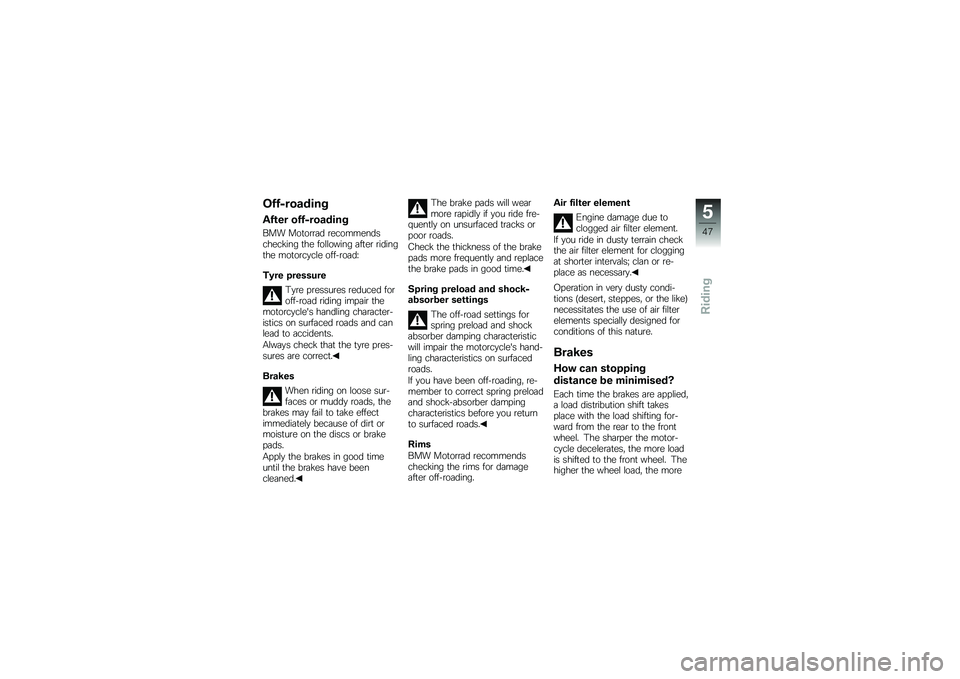
Off-roading
After off-roading
BMW Motorrad recommendschecking the following after ridingthe motorcycle off-road:
Tyre pressure
Tyre pressures reduced foroff-road riding impair themotorcycle's handling character-istics on surfaced roads and canlead to accidents.
Always check that the tyre pres-sures are correct.
Brakes
When riding on loose sur-faces or muddy roads, thebrakes may fail to take effectimmediately because of dirt ormoisture on the discs or brakepads.
Apply the brakes in good timeuntil the brakes have beencleaned.
The brake pads will wearmore rapidly if you ride fre-quently on unsurfaced tracks orpoor roads.
Check the thickness of the brakepads more frequently and replacethe brake pads in good time.
Spring preload and shock-absorber settings
The off-road settings forspring preload and shockabsorber damping characteristicwill impair the motorcycle's hand-ling characteristics on surfacedroads.
If you have been off-roading, re-member to correct spring preloadand shock-absorber dampingcharacteristics before you returnto surfaced roads.
Rims
BMW Motorrad recommendschecking the rims for damageafter off-roading.
Air filter element
Engine damage due toclogged air filter element.
If you ride in dusty terrain checkthe air filter element for cloggingat shorter intervals; clan or re-place as necessary.
Operation in very dusty condi-tions (desert, steppes, or the like)necessitates the use of air filterelements specially designed forconditions of this nature.
Brakes
How can stopping
distance be minimised?
Each time the brakes are applied,a load distribution shift takesplace with the load shifting for-ward from the rear to the frontwheel. The sharper the motor-cycle decelerates, the more loadis shifted to the front wheel. Thehigher the wheel load, the more
5
47
zRiding
Page 56 of 136
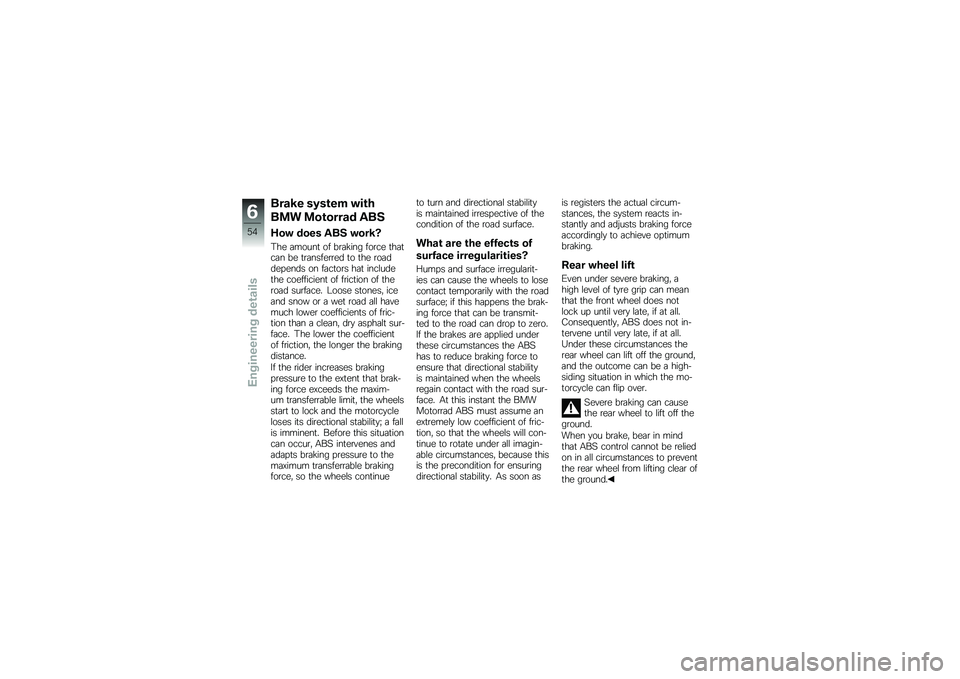
Brake system with
BMW Motorrad ABS
How does ABS work?
The amount of braking force thatcan be transferred to the roaddepends on factors hat includethe coefficient of friction of theroad surface. Loose stones, iceand snow or a wet road all havemuch lower coefficients of fric-tion than a clean, dry asphalt sur-face. The lower the coefficientof friction, the longer the brakingdistance.
If the rider increases brakingpressure to the extent that brak-ing force exceeds the maxim-um transferrable limit, the wheelsstart to lock and the motorcycleloses its directional stability; a fallis imminent. Before this situationcan occur, ABS intervenes andadapts braking pressure to themaximum transferrable brakingforce, so the wheels continue
to turn and directional stabilityis maintained irrespective of thecondition of the road surface.
What are the effects of
surface irregularities?
Humps and surface irregularit-ies can cause the wheels to losecontact temporarily with the roadsurface; if this happens the brak-ing force that can be transmit-ted to the road can drop to zero.If the brakes are applied underthese circumstances the ABShas to reduce braking force toensure that directional stabilityis maintained when the wheelsregain contact with the road sur-face. At this instant the BMWMotorrad ABS must assume anextremely low coefficient of fric-tion, so that the wheels will con-tinue to rotate under all imagin-able circumstances, because thisis the precondition for ensuringdirectional stability. As soon as
is registers the actual circum-stances, the system reacts in-stantly and adjusts braking forceaccordingly to achieve optimumbraking.
Rear wheel lift
Even under severe braking, ahigh level of tyre grip can meanthat the front wheel does notlock up until very late, if at all.Consequently, ABS does not in-tervene until very late, if at all.Under these circumstances therear wheel can lift off the ground,and the outcome can be a high-siding situation in which the mo-torcycle can flip over.
Severe braking can causethe rear wheel to lift off theground.
When you brake, bear in mindthat ABS control cannot be reliedon in all circumstances to preventthe rear wheel from lifting clear ofthe ground.
6
54
zEngineering details
Page 116 of 136
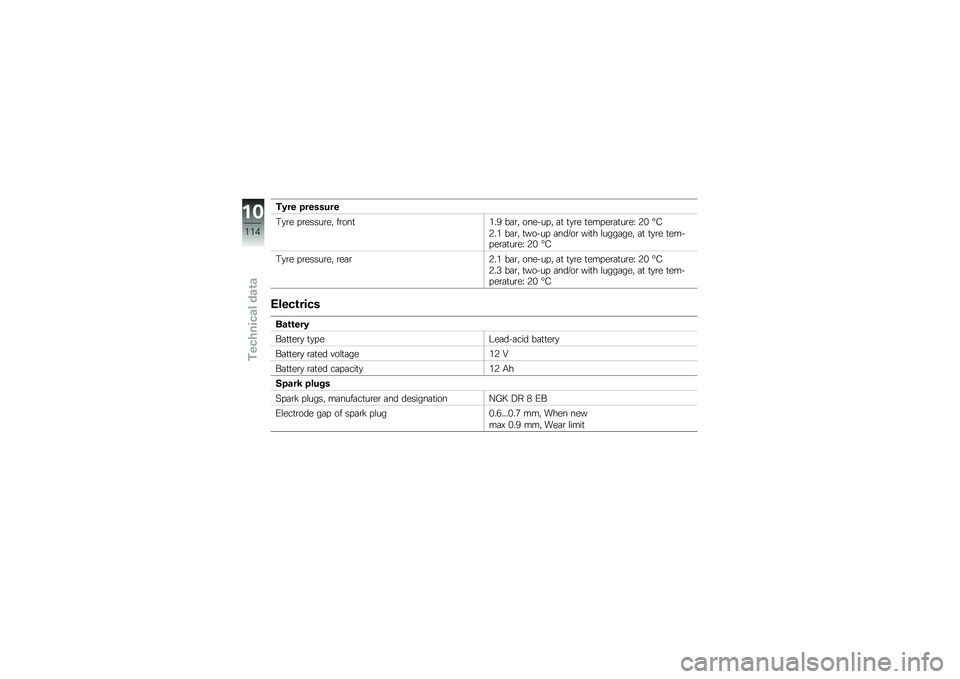
Tyre pressure
Tyre pressure, front1.9 bar, one-up, at tyre temperature: 20 °C
2.1 bar, two-up and/or with luggage, at tyre tem-perature: 20 °C
Tyre pressure, rear2.1 bar, one-up, at tyre temperature: 20 °C
2.3 bar, two-up and/or with luggage, at tyre tem-perature: 20 °C
Electrics
Battery
Battery typeLead-acid battery
Battery rated voltage12 V
Battery rated capacity12 Ah
Spark plugs
Spark plugs, manufacturer and designationNGK DR 8 EB
Electrode gap of spark plug0.6...0.7 mm, When new
max 0.9 mm, Wear limit
10
114
zTechnical data